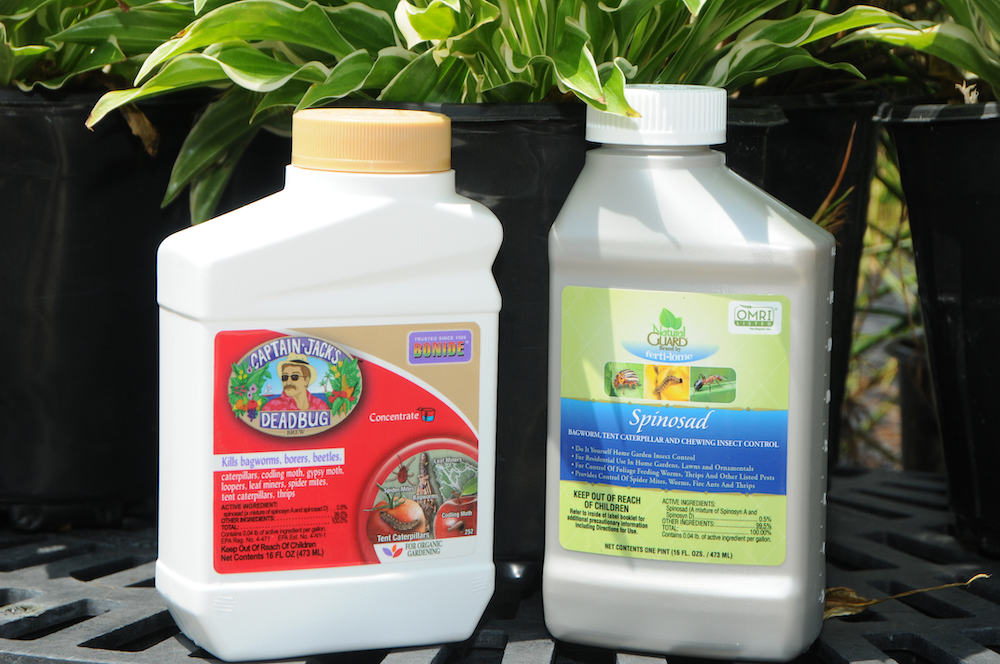Spinosad Insecticide, Vol. 7, No. 25
 Serious vegetable gardeners need to know about spinosad. This is a useful product to keep on hand for home vegetable gardens, especially fall gardens with brassica crops. It is also useful on many home ornamentals. Spinosad is sold under a variety of brand names; Fertilome, Bonide, Monterey, and Ortho all offer a spinosad product packaged for home use, and some of these products are even approved for use by organic gardeners. (The active ingredient is organic, but some products contain inorganic inert ingredients that prevent them from being considered as fully organic.)
Serious vegetable gardeners need to know about spinosad. This is a useful product to keep on hand for home vegetable gardens, especially fall gardens with brassica crops. It is also useful on many home ornamentals. Spinosad is sold under a variety of brand names; Fertilome, Bonide, Monterey, and Ortho all offer a spinosad product packaged for home use, and some of these products are even approved for use by organic gardeners. (The active ingredient is organic, but some products contain inorganic inert ingredients that prevent them from being considered as fully organic.)
Spinosad is especially useful for caterpillar control. It works great on all caterpillar pests and is much more effective than the Bt products gardeners traditionally used for caterpillars. It also has an acceptable pre-harvest interval profile and is less likely to “flare” outbreaks of spider mites, whiteflies, or aphids than most other insecticides. This is because it is less toxic to many of the beneficial insects and mites that help keep pest insects in check. That’s a big plus for a commercial insecticide, high toxicity to pests, but low toxicity to beneficials.
Spinosad also controls thrips and leaf miners and works well on some beetle pests. It is especially effective against beetles whose larvae also feed on leaves, such as Colorado potato beetles and yellow margined leaf beetles on winter greens. However, spinosad is not effective on “bugs,” such as stink bugs and leaffooted bugs, and it does not control beetle pests like cucumber beetles and cowpea curculios.
Spinosad has an interesting origin. Back in the 1980s a US scientist vacationing in the Virgin Islands happened to visit the site of an old rum distillery. Being a prospector of sorts, they collected a sample of the soil and brought it back to the lab to see if it contained any interesting microbes. They found a new soil-dwelling bacteria that was ultimately named Saccharopolyspora spinosa. Further testing revealed this microbe produced some unique secondary compounds that were highly toxic to certain insects but had low toxicity to birds and mammals, an exciting combination if you are prospecting for new insecticides.
Spinosad was first sold in the US in 1997 and since this initial introduction for caterpillar pests in row crops, it has proven useful in a wide range of other situations: caterpillar control in home and commercial vegetables, caterpillar and thrips control in ornamental plants, insect control in stored grains, flea control in dogs and cats, horn fly control on cattle, and even head lice control in humans. Spinosad is produced using a fermentation process. The S. spinosa bacteria is grown in culture in large vats so the active ingredients they produce can be harvested, concentrated, and formulated into insecticide products. The final product does not contain any live bacteria, only the toxins produced by the bacteria.
If you are growing brassica crops such as cabbage, bok choy, broccoli and collards in your garden this fall, you may want to get a bottle of spinosad. These crops are attacked by a lot of caterpillar pests: armyworms, loopers, cabbageworms and diamondback moths, as well as leaf-feeding beetle pests such as yellowmargined leaf beetle. These pests tend to be more abundant in the fall, and spinosad is one of the most effective treatments available.
See Extension Publication 2347, Insect Pests of the Home Vegetable Garden for more information.
Blake Layton, Extension Entomology Specialist, Mississippi State University Extension Service.
The information given here is for educational purposes only. Always read and follow current label directions. Specific commercial products are mentioned as examples only and reference to specific products or trade names is made with the understanding that no discrimination is intended to other products that may also be suitable and appropriately labeled.
Mississippi State University is an equal opportunity institution.
Bug’s Eye View is now on Facebook. Join the Bug's Eye View Facebook group here.

